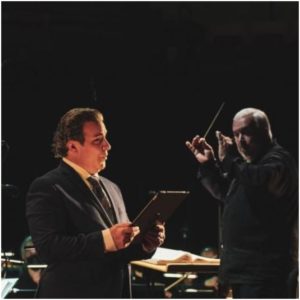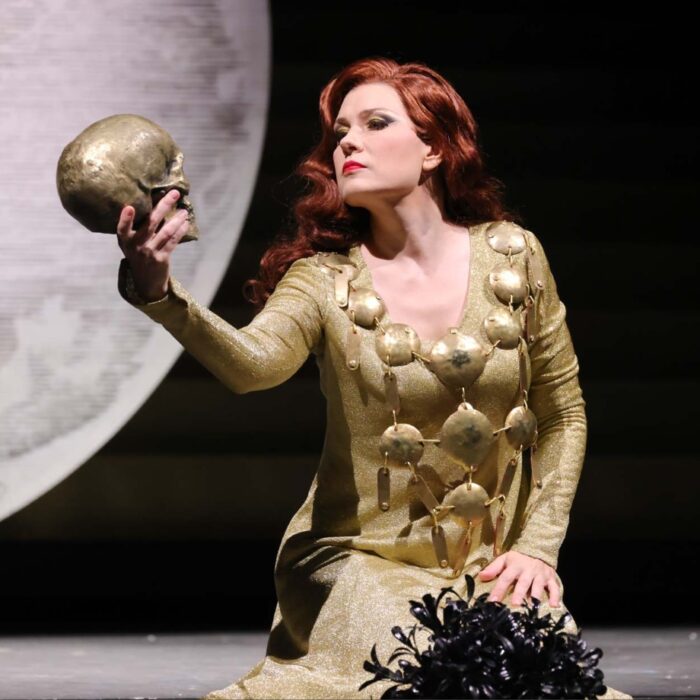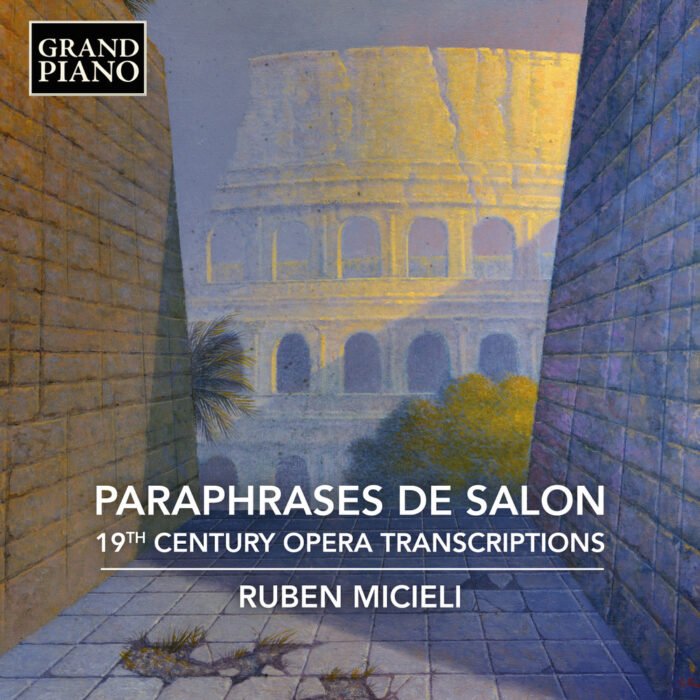
Opéra National de Bordeaux 2021-22 Review: Robert le Diable
Erin Morley, John Osborn Lead a Fantastic Cast in this Incredible Reading of Meyerbeer’s Early Masterwork
By Mauricio Villa(Credit: Pierre Planchenaul)
“Robert le Diable” premiered at the París Opera in 1831. The immediate success of the piece led its composer, Giacomo Meyerbeer, to sudden international stardom. This opera set the standard for French Grand Opera, with the story divided into five acts, ballet numbers, great pompous chorus scenes, and the latest theatrical effects. It became the ultimate form of composition and theatrical production of the mid-nineteenth century.
The original cast featured some of the greatest artists of the time including tenor Adolphe Nourrit and the Romantic era ballerina Marie Taglioni. In fact, the ballet in this opera is what set a precedent in the Romantic movement. The unusually gruesome and even blasphemous dance of the dead lascivious nuns created the image of the Romantic Ballerina who crosses the stage dancing on point shoes and wearing long tutus creating the illusions of floating ethereal spirits, which will influence the romantic ballets like “La Sylphide” (created for Taglioni too) or “Giselle.” By 1834, the opera had reached over 100 performances in Paris, and Nourrit sang the lead role until 1837 until he was replaced by tenor Gilbert Duprez, who managed to emit the first high C with full chest resonance rather than the mixed head voice used until that moment to sing the extreme high notes.
But how did such an iconic opera fall into oblivion? With the arrival of verismo opera, the extremely long romantic plots became obsolete, as did the use of scales, extreme tessituras, and coloratura. But one of the most important reasons for the opera getting lost is that there have been no male voices able to do true justice to the roles of Robert and Bertram. The roles could be compared to the French version of “Tristan” because of length and the demanding tessitura. Both roles cover more than two octaves with Robert having to sing between low C and high D and Bertram singing between high F sharp and low E flat. In both cases, lighter voices could sustain the hard tessitura and reach the top notes but had trouble with the German-influenced Meyerbeer orchestration. Heavier voices have a more heroic powerful approach but struggle with the extreme top notes.
Opéra National de Bordeaux opened its 2021-22 season with three semi-staged performances of this opera.
Specialist Singers
The American tenor John Osborn who played the role of Robert has the perfect vocalitá for this role. He has an extremely wide vocal range with a dark center and well-supported low notes. Above all, he has an exquisite ability to color every line throughout his register. He sings with this constant chiaroscuro. Therefore, his high notes seemed like a logical progression of the vocal line rather than explosions of loud unbelievable high tones from lyrical voices or the light quality of leggero tenors. The first Act ends with a “Sicilienne,” a difficult piece for its traditional and heroic rhythm and melody, where he delivered the first two high C’s of the night; seven bars later he must hold another high C and then resolve down two octaves to low C. This is followed by the “Jeux” scene, nonstop singing for the tenor, keeping the voice mostly in the middle range which is a difficult zone for a tenor to be heard over a whole choir, two basses, and dense orchestration. And this is only the first Act.
The second Act opens with the rarely heard tenor aria “Où me cacher?…Oh! ma mère!” (According to my research it has never been performed or recorded in the last revivals of the opera). Meyerbeer marks the piece ”dolce” (“sweet”) and this is just how Osborn interpreted this lyric moving piece, with his clever use of mezza voce, diminuendo on high B flats, and soaring pianissimi. He maintained ease and fluidity during the last bars of this remarkably difficult seven-minute scene. This was by far the highlight of his performance which was warmly rewarded by the enthusiastic audience.
But the hardest was yet to come. The tessitura of the role keeps going up in both Acts two and three. In the third Act duets with Alice and Bertram, the writing becomes quite high and contains a devilish cadenza, with the added difficulty of being “a capella,” leaving the singers completely exposed. Osborn easily and sweetly manages these passages, singing the marked pianissimo with extreme delicacy. He quickly shifted to a more heroic sound for the subsequent duet with Bertram. Osborn approached the impossible line “non, non, non, Je ne crains rien” with a direct attack on the high D natural before slowly descending to a sustained High C sharp, C, and B natural. This is a perfect example of the difficult writing that makes it so hard to cast today, but Osborn made this line sound beautiful with his mezza voce, control of his top register, and secure clean attack on high notes. Still to come with an equally demanding score were Acts four and five. Osborn paced himself extremely well, managing to keep a fresh and clean voice throughout the entire opera.
French bass Nicolas Courjal sang the part of the devil Bertram. Unlike his colleagues, who were making role debuts, Courjal had previously sung this part in Brussels. He has a metallic instrument, modest in volume, but with a splendid low register that shined on the several low F and E flats throughout the score. Courjal managed his role bravely, fulfilling the role with a sarcastic cynicism that was highlighted by his native tongue. But his high register sounded open, dry, and distant. “La valse infernale” ends with a high F sharp, and here his voice was round, dark, and projected up through the high E; however, it lost all these qualities as he reached the F sharp.
Bertram has a fair amount of coloratura and quick syllabic singing, like in the comical duet with Raimbaut which opens the third Act, and in the duet with Alice. Courjal’s voice did not seem agile enough as scales and quick sections sounded blurred. Nevertheless, he ended the duet with a cavernous low E flat. Bertram it is an ungrateful role, it has a lot of music but mostly singing in duets or ensembles, no brilliant solo moments. Plus, it requires a big dark voice that can sing extremely high and low notes and has agility at the same time. Big dark voices are by nature not as flexible or agile as higher voices and as a result, it’s so difficult to find a voice that matches all these demands. Courjal is a great bass and interpreter, but he is clearly more comfortable in a pure bass tessitura, although he sang every single note written in the score.
Erin Morley portrayed the princess Isabelle. Morely is a true Lirico-leggera soprano, with a beautiful velvet quality timbre from low register up to high C and then sparkling top notes. Her interpretation of her opening aria “En vain J’espere” showed off her clean coloratura, her long melancholic legato phrasing, and her crystalline color on the several B naturals written in the score. The coloratura increases in the cabaletta “Ah viens Robert” with long fast scales. Morley did not only sing a secure immaculate coloratura but filled the notes with emotion and meaning, almost making you forget the vocal fireworks. She performed a beautiful cadenza between the two verses of the Cabaletta which reached a whispered B natural, and sang effortless trills, staccato notes, and long scales, including a two octaves scale from high B to low B natural. Morley coronated the ending with a brilliant and securely sustained E natural.
Her top notes are so stable and brilliant that she interpolated an unexpected high F in the battle scene during the solo cadenza “allons aux armes.” Even though the music of “Robert le Diable” has not been popular for over a century and a half, the most recognizable aria would be Isabelle’s fourth Act aria “Robert, toi que j’aime” as it has been recorded and sung in concerts by many sopranos. Morley’s interpretation was dolent, moving, and full of pathos, coloring the legato lines with multiple dynamics and showing a mastery of diminuendo/crescendo phrasing. It was the most applauded number of the evening.
Lyric soprano Amina Edris portrayed the role of Alice. She has a velvety timbre, with an even, fair vibrato. In spite of her big volume, she has an astonishing ability to sing pianissimi and extreme diminuendi in her top register. She proved this during her entrance aria “Vá! vá! vá! Dit elle” which, although written mostly in the middle register of the voice, has several ascensions to B naturals, all of which Edris emitted with crystalline tone. After the second Act, she returned to the stage to sing “Quand je quitais la Normandie” which follows the same musical pattern as the first appearance. She sang with her expansive dark center, rising easily again to several B naturals, and even a high C in the final cadenza, all while maintaining even rich harmonics throughout her entire register.
Expert Direction
Marc Minkowski, the Baroque master and general director of Opéra National de Bordeaux oversaw the orchestra. His attention to detail and precision was exquisite. Sections of the orchestra melted into each other while at the same time shone brightly on their own. The opera took place in a classical auditorium which can leave the orchestra’s sound exposed and can quite easily blur sections together. However, Minkowski’s reading was precise, energetic, and at moments so intense that it perfectly accounted for the risks of the venue’s acoustics. He offered an almost complete version of the score, including the ballet music which he made sound lively and lyric. Sadly, the chorus, which was spread out at the back of the auditorium (no audience was seated on the far side seats), sounded unclear and distant, especially when the orchestra was at its most bombastic. I guess this position was adequate for the recording but did not help the performance.
This was an impressive restitution of Meyerbeer’s masterpiece, with an excellent cast of singers able to accomplish the extreme vocal demands of the score and continuously fulfill the music with emotion – something not easy to achieve in a four-hour romantic opera. The release of the CD will be a must-buy for opera lovers.


